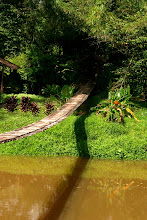I can't show you pictures of the fireflies, I'm sorry. Their luminance on the Mangrove trees can't be captured from the boat. But I assure you, there's no place and time more romantic than firefly watching at Iwahig River, Puerto Pincesa, Palawan, Philippines. In fact our boatman/tourist guide related how some of their guests proposed while they were cruising the river watching the fireflies.
What are fireflies?
Fireflies
are also nicknamed as Lightning Bugs. Do you think that they are in the family of flies? No, Geleena, they are nocturnal luminous insects of
the beetle family Lampyridae. This beetle family consists of about 1,900 species that inhabit
tropical and temperate regions. The common glowworm is a member of this family.
Fireflies
are actually soft beetles which sizes range from 5 to 25 millimetres in length. Look at the underside of their abdomen: it has a special light organs that glows
in luminous flashes. The flattened, dark brown or black body is often
marked with yellow or orange. Most of the fireflies feed on pollen and nector
but for adult fireflies they do not eat. They like to live in Mangrove trees.
How do fireflies flirt?
What are their mating calls? The female fireflies will produce a short rhythmic
flashes that attracts the males fireflies. The females will sit on the ground
in the high grass to flash to certain male only. See, they don't flirt mindlessly at all. The female chooses the males
based on their flash pattern.
We know how fireflies flashed is
because of biomechanics, but we did not know why they flashed.
Though both males and female flash,
it’s the male who make pattern in the air. Females are either short- winged and
stationery’ attached to the tips of plant stems or leaves as they carry on a
flirty dialogue with roving males, trying to draw them in to mate.
However,
others feel that the flashing is not to attract the opposites but as a
mechanism of warning to advise predators of the fireflies bitter taste.
Unfortunately, some frogs like to eat them.
How do fireflies produce their light?
They are produced under a nervous control within
special cells which are richly supplied with air tubes. Only the light from the
visible spectrum is emitted. Fireflies
do not bite, do not have pincers, do not carry disease and in fact are quite
harmless. They cannot even fly fast. They have a life span of two months.
Why do they flash?
Fireflies “cold light’ is made by a process known as bioluminescence or
chemiluniscence, in which a substance called luciferin comes in contact with
enzyme luciferase and oxygen. As air rushed into the abdomen, it reacts with
this compound and a chemical reaction gives off the familiar glow of a firefly.
Fireflies can regulate the airflow into the abdomen to create a pulsating
pattern.
Fireflies are alone among
bioluminescent insects because they can flash; other glow constantly. The
process emission of the light from living things, without significant heat
sometimes called “cols light”. Bioluminescence is found in species of bacteria,
male and female of fireflies are used as species- specific signals for mating.
The light stick has two separate
compartments with two chemicals join together. As molecules from the different
chemical bind to each other they give a kick of energy to some of the
electrons. But electrons never hold on to extra energy for long.
That molecule then needs to get rid
of its energy in some way. It can sometimes do it by colliding with other
molecules and losing it through collisions, but arrange system in a careful
way, the excited product might have no other way to excite except by physically
releasing the energy as photons and the photon comes out as a fire of light and
we see that as the burst given off by a firefly.
Though both males and female flash,
it’s the male who make pattern in the air. Females are either short- winged and
stationery, attached to the tips of plant stems or leaves as they carry on a
flirty dialogue with roving males, trying to draw them in to mate.
While each firefly species has its
own pattern of flashing, some female imitate the patterns of other species.
Males land next to them only to be eaten alive. So keep in mind that its
flickering isn’t just a wonder of the night, it’s also a language of love.
Source: http://www.malaysiasite.nl/fireflies1.htm
How to go to Iwahig River:
Iwahig river is
located at Highway km. 20 Barangay Iwahig Puerto Princesa City,
Palawan. You may ride a bus from Villacorta and ask the conductor to let you off at Iwahig. Or you may have a travel agency set up a group tour with you. We went on a group tour at P1,100 per person. The firefly watching is for P900 only, but it's a good value for your money to include a dinner as the dinner is a festive affair at Skylight Hotel. It's a sumptuous buffet dinner. In fact I will treat you to some food pictures as I don't have pictures of the fireflies.
 |
|
| I cant' show the over 100 dishes to choose from the buffet, but this is
my plate with my faves - kangkong, Sushi, tofu, fried okra, sweet
& sour pork, lechon, pork asado | | |
|
| I even went for a 2nd helping (What a pig I am :) Fried quail eggs, fried breaded mashed potatoes, lumpia, pudding and cake |
|
|
|
If firefly watching won't awaken the romance in you, maybe the tranquility of the river would at least relax you.
References:
http://www.malaysiasite.nl/fireflies1.htm
Includes FREE planning and background information. You can never escape
it. Everywhere you look there it is. Whether it-s the Sulu Sea to the
east or the South China Sea to the west, as much a highway as a source
of sustenance, nothing defines Palawan more than the water surrounding
it. The proverbial island paradise with seascapes the equal of any in
Southeast Asia, wildlife, both terrestrial and aquatic, this, the
Philippines- most sparsely populated region is also its most beguiling.
Historically, it was always an outlier, an island apart. Known as Pa Lao
Yu (island of beautiful harbour) before the arrival of the Spanish who
later referred to it as paragua (umbrella) for its shape, control of
Palawan was contested by the colonisers and Moros from Borneo for over a
hundred years. These days the struggle is overdevelopment versus
maintenance of the largely untouched environment. Gaisano, Robinson-s
and SM - the signifiers of urbanisation elsewhere - have yet to make
inroads. Because of its silhouette - a long sliver stretching 650km all
the way from the Mindoro Strait to the tip of Borneo - there-s a certain
liberating logic to travel in Palawan. Centrally located Puerto
Princesa, the administrative and culinary capital, is also the transport
hub. To the south, where there-s little government footprint, populated
by indigenous tribal groups and Muslim communities, it-s rough but
potentially rewarding travel for those with reserves of endurance. The
majority of travellers go north, without question the highlight.
Watching the sunset standing on El Nido-s ramshackle beachfront with a
glorious view of Cadlao Island, or skimming along in a bangka around a
maze of uninhabited islands in the Calamian Group feels somewhat
post-apocalyptic - like the morning after the proverbial flood.



































